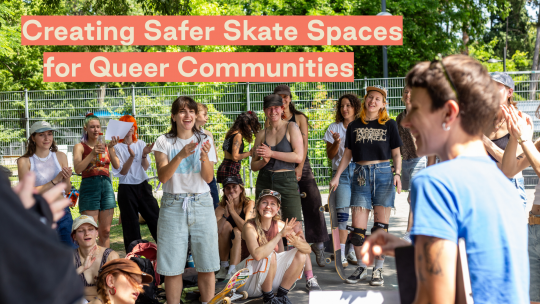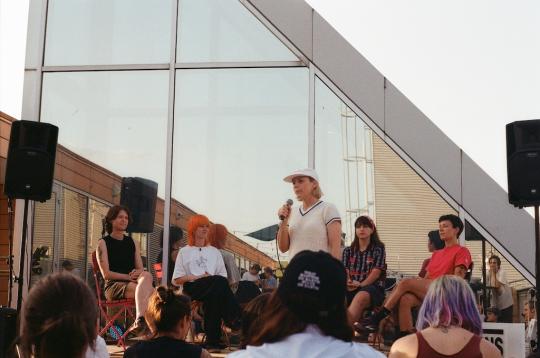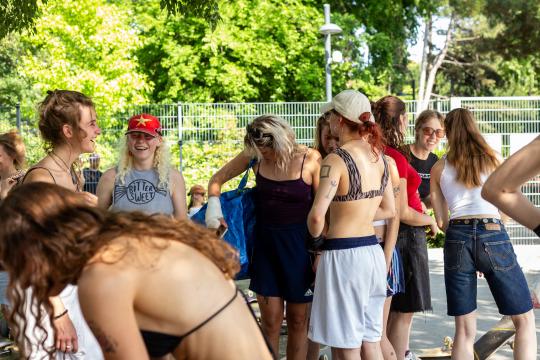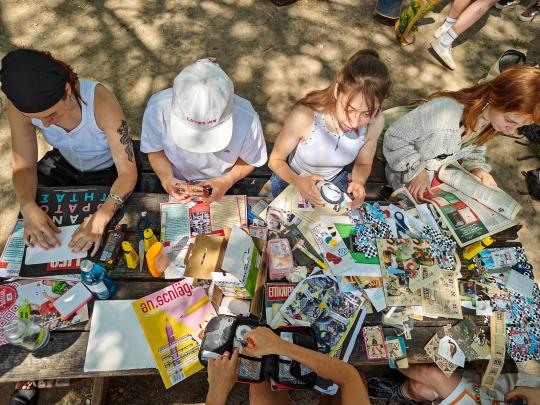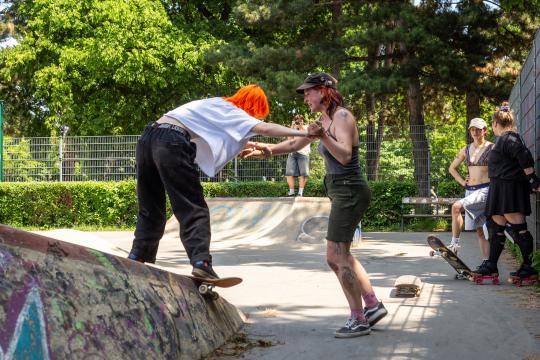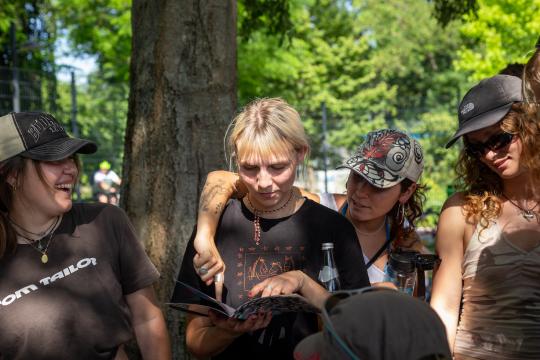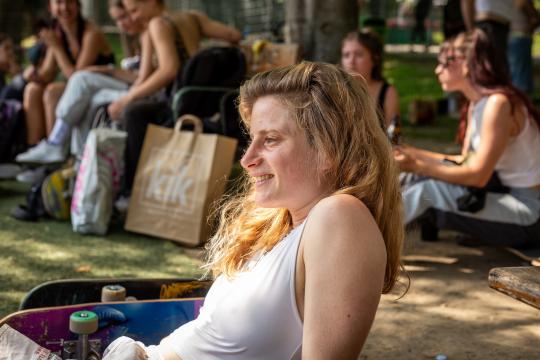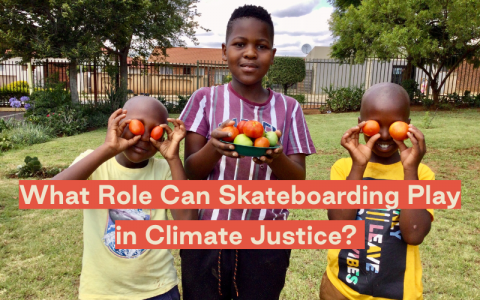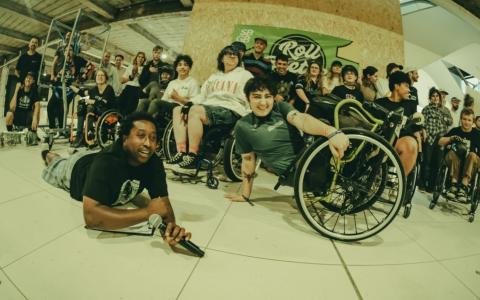A thought piece by Goodpush's Ruby Mateja
Note: This piece is written from my lived experience as a queer, non-binary person based in Europe and mainly reflects the realities and communities I’m part of here. Goodpush is currently developing a new e-course module on Queer & Trans Inclusion in Skate Spaces, which will explore more global perspectives through case studies from projects around the world, helping to reflect the diversity of local contexts and the current challenges and opportunities for inclusion.
What is a Safer Space?
I recently attended the Gnarathon Festival in Vienna, Austria, and participated in a panel discussion focused on safer spaces for FLINTA* communities in skateboarding. Leading up to this, I reflected a lot on safer and inclusive spaces for queer communities in skateboarding (and more widely)—what we’re currently getting right, and where there’s room for improvement—and this piece is an attempt to organise those thoughts into one place!
A ‘safer space’ refers to an environment that intentionally works to be welcoming and free from discrimination or harassment—especially for communities who are often excluded or marginalized. These spaces often exist to support specific communities, such as queer or trans people, and aim to make these groups feel respected, seen, and around supportive people who they can relate to and connect with.
We say ‘safer’ rather than ‘safe’ because absolute safety can never be guaranteed, especially in public spaces. It’s important to note that the idea of the perfect inclusive or safe space is most likely never achievable when it is trying to accommodate the needs of a diverse group. On top of that, everyone’s idea of a safe place is unique and subject to change; what feels safe to one person might not feel safe to another. The term ‘safer’ also acknowledges that this process is a work-in-progress—it's about committing to listening, learning, and adapting in response to all of the people that the space is trying to include.
Building safer spaces is an ongoing process which requires planning and reflection. It’s a process that shouldn’t just be down to those with lived experience—having active support from allies really helps to create wider inclusivity that isn’t confined within the small bubbles of exclusive spaces. For non-marginalised communities, it might seem surprising that a small skate event or informal meet-up could make someone feel unsafe—but the reality is, you can never guarantee safety for everyone.
Why Do We Need Safer Spaces for Queer Skate Communities?
Amongst a rise of ‘gay-friendly’ cafes and bars in many European countries, we’ve actually seen a lot of regression in queer and trans rights over the past few years—from anti-trans legislation in the UK and the US, to ‘LGBT-free zones’ in Poland and censorship in Hungary. Long-standing LGBTQIA+ (Lesbian, Gay, Bisexual, Transgender, Queer, Intersex, and Asexual. The ‘+’ represents other identities not explicitly listed, such as non-binary and pansexual) venues that remain open often cater to wealthier, more mainstream and assimilated* parts of the LGBTQIA+ community and can exclude those of us who don’t fit neatly into the more traditional gay or lesbian categories or are marginalized in cis-society due to our gender expression.
In these environments, marginalised queer identities (especially trans, non-binary, and gender non-conforming people) can feel underrepresented, uncomfortable, or even unsafe. Not to mention the groups of people within these communities who also face marginalization and exclusion at an intersectional level—displaced people, people of colour, and those from low-income backgrounds. The effort to create truly inclusive spaces means understanding this exclusion on multiple levels and actively working to address the barriers.
Inclusive queer skate spaces can go a long way towards breaking down these barriers and creating caring community hubs where diversity can thrive. Unlike ‘gay friendly’ venues, which in their nature are primarily businesses that require you to spend money to access the space, queer skate groups can provide free access to skateboarding and community. That for me is a key point of a safer space—it actually allows you the opportunity to stop wasting your energy scanning for potential danger so that you can put it towards connecting with others, organising, gaining strength and confidence, and taking that momentum out into the world to make some changes, inspire others, or just enjoy the feeling of calmness that it brings.
Tips for Building Safer Queer Skate Spaces
Last year, Goodpush and a handful of social skate projects based in Europe and Australia (@respectisrad, @soaparis, @thebabygexperiencesb and @skate_cityplanner) co-created a set of Safer Spaces Guidelines to support others to better plan for safer and more welcoming skate events. The guidelines are designed to help skateboarding event teams uphold best practices for inclusivity and to prioritize the safety of all attendees, whether the event is a festival, competition, jam, film screening, or conference.
As a start, here are a few ideas and practical ways to work towards queer inclusion in your skate spaces:
-
Start with Representation: If you're working to create an inclusive space for queer communities, begin by involving people with lived experience. If you want your event or group to be trans-inclusive, bring trans voices into the conversation as early as possible and make sure all identities have an equal say.
-
Use Inclusive Language & Imagery: Representation begins before someone even sets foot in your space. The language, visuals, and tone of your communications go a long way to show inclusion. Ask yourself: does our poster, post, or website reflect who we hope to welcome?
-
Be Transparent: Let people know who you are and who’s currently involved. Transparency builds trust and invites participation. Always provide information about the accessibility of your space as well, so that people with visible and invisible disabilities can make informed choices about joining. For example: “We’re a group of queer skaters made up of lesbians, bisexuals, non-binary and asexual folks. We’d love to connect with other groups or individuals to better reflect the wider queer community.”
-
Ask for Feedback: Anonymised feedback forms can help you understand what’s working and what’s not. Ask your community: “What makes a space feel welcoming and safe to you?” Mapping this out with input from diverse voices is a great first step and something that you can also revisit to stay on top of things.
-
Plan for Inclusion and Safety Early: Safer spaces don’t just happen overnight. If you’re organising an event, start planning for inclusion and safeguarding from day one:
-
Involve diverse voices in planning
-
Create and share a clear code of conduct (ie. include it on the registration form)
-
Organise de-escalation training for staff and volunteers
-
Appoint “floor angels” (awareness teams) to support in case of incidents or concerns and establish clear reporting mechanisms (in some cities there are organizations dedicated to providing this service at events)
-
Display your community guidelines at the event and online
-
Have clear procedures set up and all staff and volunteers confident to follow them
-
FLINTA* Skate Spaces: Who’s Being Left Out?
I first heard of the term FLINTA* four years ago during a Goodpush event we organised in Berlin bringing together social skateboarding initiatives across Germany to share knowledge and best practices. I had assumed that it was a relatively new term and was surprised to find that it came into prominence in the 70s and 80s within the German-speaking left-wing activist scene. Emerging from the feminist movement’s efforts to create safer spaces for women and lesbians and later evolving to include other marginalized gender identities.
It’s important to note that FLINTA* and LGBTQIA+ are related but distinct terms. LGBTQIA+ is a broad umbrella term for people of different sexual orientations and gender identities. While both terms include non-cisgender identities, FLINTA* is more specific in that it aims to be inclusive of diverse gender identities which are all marginalised by patriarchal and structural power structures. For example, a cisgender heterosexual woman would not be included under the LGBTQIA+ umbrella, but would be included in FLINTA* spaces. A cisgender gay man would not be included under the FLINTA* umbrella but would be considered part of the LGBTQIA+ community. It seems to me that LGBTQIA+ as a term at present date is more mainstream and traditional, whereas FLINTA* has its roots in the activist, self-organised, feminist movements.
At the recent Gnarathon Festival panel in Vienna, we discussed the rise of FLINTA* skate spaces (particularly in German-speaking contexts, although I have seen FLINTA* being used in different locations more recently) and how many skate groups previously creating space for girls and women have adapted their language and messaging to be inclusive of all FLINTA* identities. We discussed the fact that many of these spaces are still dominated by cisgender women or queer femme-presenting people. As a result, more masculine-presenting queer folks and transmasculine people often feel completely excluded.
Sometimes, exclusion hurts most when it comes from a space that claims to be for you. I believe many organisers have good intentions but fall short in representation and active efforts towards diversity. Inclusion takes time and effort—and it’s always worth checking in with yourself and your group to ask: Who’s not in the space? Who’s not skating with us? Why? It’s not just about who you say is welcome, it’s about who actually feels welcome and not alone there.
If your current FLINTA* space includes primarily cisgender women and femme identities, you could consider:
- Clarifying your name and scope if that's who your space is for (femme-only dedicated spaces are also fine!)
- Actively widening your efforts to reach all FLINTA* folks—and making space for them to be actively involved in shaping the space.
- Reaching out to other groups who represent other FLINTA* identities, seeing how you might learn from them or collaborate together.
We Can Do Better Than This
In the face of wider political setbacks, there’s also a wave of hope. Across the skate world and beyond, grassroots queer and trans-led initiatives are building meaningful spaces: community-led, DIY spaces that prioritise care, connection, collective action and healing. These groups—like Unity Skateboarding (California), Trans Skaters (London), Slayte Skateboarding (Paris), DENCITY.NG (Lagos) and many more—didn’t come from nowhere. Often, they emerged by the coming together of people who were pushed out or unseen by the traditional skate scene for years. It’s usually these people who set the tone of ‘we can do better than this’ and start with small, intentional steps to carve space for their community who were cast on the sidelines or even gave up skating due to lack of safer spaces. Allies can do this work too though, and play an important role in pushing for inclusivity.
Tips for Allies
- Step back so others can step forward: Use your position to uplift voices that aren’t usually heard. Pass the mic when possible, and (please!) don’t take up space in communities or events not intended for you.
- Stay curious and put in the effort: Learn the basics of queer and trans inclusion on your own time, and don’t rely on folks with lived experience to educate you. Check out the resources listed below as a starting point.
- Speak up—especially when it’s uncomfortable: Call out/in discrimination, misgendering, or exclusion when you see it, even if it’s subtle. Sometimes your voice carries more weight in cis/straight-majority spaces.
- Respect boundaries and self-identification: Use correct names and pronouns, don’t make assumptions, and respect what people tell you about their identity or needs—even if you’re unfamiliar with the terms. If you make a mistake, don’t panic, correct yourself and move on!
- Be there consistently: Allyship isn’t a trend or one-off. Show up regularly, donate to queer-led initiatives, attend events where possible and support the ongoing work of building inclusive communities. Be open to feedback and keep learning.
Creating safer queer skate spaces doesn’t mean ticking boxes or reaching an end point. It means staying curious, asking questions, not assuming, and doing the work to build spaces that are inclusive, affirming, and joyful. Let’s keep asking, keep checking in, and keep building the cute queer skate spaces we all deserve.
Resources to Check Out
Here are some resources to keep learning and building inclusive and safer spaces:
- https://www.friendsjoinersarms.com/join-toolkit (this page also has links to all the resources mentioned in the toolkit) — The JOIN Project.
- Organizer Guidelines for Safer Skate Events & Community Guidelines Template – A collaboration between the Goodpush, @respectisrad, @soaparis, @thebabygexperiencesb and @skate_cityplanner.
- LGBTQIA+ Community Resources — The Trevor Project
- Skate Program Toolkit — Skate Like a Girl
- From ‘safe’ to ‘brave’ spaces: pedagogical practices of exclusion to promote inclusion within & beyond skateboarding — Becky Beal and Robert Petrone
- A Bit Fruity with Matt Bernstein (podcast)
-
Calling IN: A Less Disposable Way of Holding Each Other Accountable — Ngọc Loan Trần
